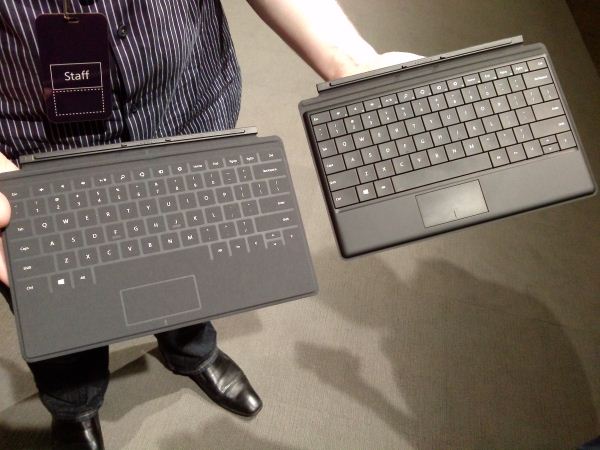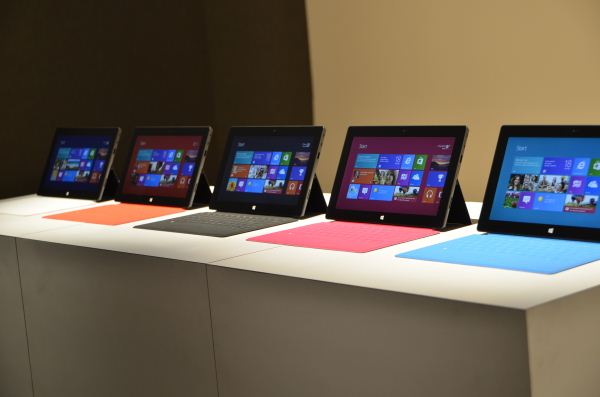Microsoft Surface - We Go Hands On [UPDATE: Detailed Impressions]
by Vivek Gowri on June 18, 2012 11:32 PM ESTPost-announcement, Microsoft took us to a backroom in Milk Studios to give us hands on experience with the Surface. They weren't lying, even the preproduction units feel awesome in hand. The magnesium panels are finished with partial vapour deposition, a process that deposits a thin-film coating onto the panel using vacuum deposition (molecule-by-molecule deposits at sub-atmospheric pressure.) It gives the unit a distinctly premium feel, and one that's pretty different from most of the other metal-bodied systems out there particularly with the current trends towards anodization and brushed finishes. The body is 9.3mm thick (a tenth of a millimeter thinner than the latest iPad), and total weight comes in at 676g (or about 1.49 lbs), so it's denser feeling than the iPad.. The 31.5Wh battery isn't as large as the iPad's 42.5Wh, but the 1366x768 10.6" LCD definitely draws less power.
The hinges in the kickstand are spring-loaded, giving a very positive mechanical feel and noise. The hinge mechanism is particularly robust, and as mentioned in the keynote, was acoustically tuned to sound high quality. Microsoft seemed particularly OCD about certain design details, this being one of them. It paid off though, with a hinge that looks and feels ready to take a lot of abuse. The stand props the system up at 22 degrees, which is a common theme - the beveled edges are all angled at 22 degrees, and the rear camera is also angled at 22 degrees in the opposite direction. This is a pretty interesting one, since it means you can keep the tablet angled as is usually comfortable, and still shoot video straight ahead. It's a good idea, though probably one that will take a bit of adjustment in real life use.
My personal favourite part of the Surface is the cover. There's two of them - the Touch Cover, and the Type Cover, both with integrated keyboards and touchpads. The Type Cover has a traditional keyboard, albeit one with particularly shallow feel, along with physically clicking mouse buttons. The Touch Cover is very interesting - it has a pressure sensitive membrane keyboard with felt keys and mouse buttons housed in a cover that's totally 3mm thick. (The Type Cover is ~5.5mm thick). I wasn't able to get a feel for how typing actually feels on it, so I can't comment on responsiveness or accuracy, but our friend Ben Reed at Microsoft Hardware swears he can top 50 words per minute on it any given day. I'm inclined to believe him, but I can't comment firsthand until I can actually play with a working unit.
The outside of the covers is covered in a felt material, and when closed, the unit feels like one of the velour or felt-covered journals. It gives a decidedly organic, natural feel to a very inorganic device, something that Microsoft was very pleased to note. It's a pretty awesome idea, actually, taking the best parts of Apple's Smart Cover and ASUS' laptop dock and merging them together into one of the most innovative cases we've seen. I took away three major things from this event, and the only one them that directly related to the device hardware being shown off was that integrating the keyboard into the cover was a stroke of awesome. (I'll go more in depth on the others in a larger post later today.)
For the first time, I can really see a tablet replacing a notebook as my primary computing device. Before today, I couldn't say that with any real conviction - I tried it with the iPad on multiple occasions, and it just didn't work. I'm a writer, tablets aren't ideal for writing. Surface changes that in a big way. And that's really what Microsoft is going for here - a device that fits into your life as a versatile tool to do anything you want it to. Whether they'll succeed in capturing the market is a story that will be told after Surface launches alongside Windows 8 later this year, but for now, this is a very promising start.




















161 Comments
View All Comments
faizoff - Tuesday, June 19, 2012 - link
I may have glossed this over but when are these tablets going to be available?Braumin - Tuesday, June 19, 2012 - link
October for the Windows RT version (ARM) and a couple months later for the Intel.Belard - Tuesday, June 19, 2012 - link
Next year... So by then... Apple and Android tablets would be 2 generation ahead.Both of these are sub-standard compared to the latest Android and iPad3.
Spunjji - Tuesday, June 19, 2012 - link
Wrong, wrong and speculative. But nice try.mcnabney - Tuesday, June 19, 2012 - link
The RT will be almost 2 generations behind. Tegra 3 in Q4 will be a whole year old. With iPad3's resolution and Transformer Prime going 1920x1200, heck the Google Nexus 7 will have about the same resolution as Surface RT, but in a 7" package instead of a 10.6". Microsoft didn't anticipate the jump in resolution in 2012 and showed up ready to compete in the 2011 market. If Surface RT came out in 2011, it would be competitive - it just isn't in 2012.steven75 - Tuesday, June 19, 2012 - link
Microsoft is often skating to where the puck is instead of where it's going. My hope is Windows 8 will be the OS where Ballmer *finally* gets canned and maybe Microsoft can rebound.mcnabney - Tuesday, June 19, 2012 - link
I hope not.MS has been a belligerent competitor in the market. The sooner they are gone, the better. I can totally imagine an MS-free world. Sadly, the Windows/Office monopoly allows them to dump billions toward nonsense and prop-up weak assets like Zune, Bing, and the X-Box (which only succeeded by sucking the life out of PC gaming and being sold at a loss for a long time).
sviola - Tuesday, June 19, 2012 - link
"I hope not.MS has been a belligerent competitor in the market. The sooner they are gone, the better. I can totally imagine an MS-free world. "
And this throws away any credibility your comments had.
mcnabney - Tuesday, June 19, 2012 - link
So you don't think that Microsoft has grossly benefited from the Win/Office monopoly?Belard - Tuesday, June 19, 2012 - link
Yes and no...I'd like to see Microsoft end up with 30% of the desktop market. Apple with 30% and Linux with 30%. (Amiga get 10%!!! whatever J/K)
To have MS totally die would be a BAD thing. They are not great, but they did create a crappy but standard platform.
Win8 breaks the standard quite a bit.
MS cannot survive without OS/Office. If they are knocked down to 1/3rd their size... Windows will become cheaper... never cheaper than Linux, maybe Apple prices.
MS did this to themselves when they KILL PC gaming. WTF do they bother putting "XBOX" as a Windows APP? IF it doesn't allow PCs to play 360 games, its all bullshit.
No games = no need for $300~500 gaming cards.
No games, no MS-Office, No Adobe CS... then you don't need Windows.